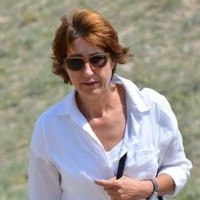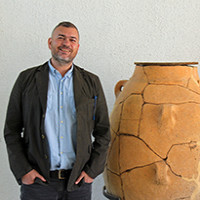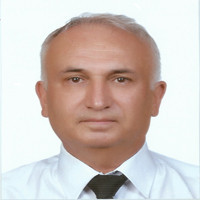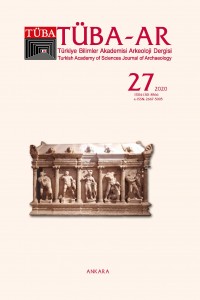Research Articles
Issue Editorial Board

Prof. Dr. Gül Işın graduated from DTCF in 1988 with a BA in Classical Archaeology. She completed her master's thesis in 1991 and studied the ruins of the ancient city of Pednelissos in Pisidia. She received her doctorate from the Institute of Social Sciences at Akdeniz University in 1998 with a thesis titled "Patara Terracottas." She became an Associate Professor in 2004 and a Professor in 2009. Her area of expertise is Hellenistic Period Coroplastics and Sculpture. She has also worked on the Lycian Civilization, Lycian plastics, and burial customs.

After completing his bachelor's and master's degrees at Istanbul University, Department of Prehistory, Karul completed his PhD at the Free University of Berlin in 2000 on a DAAD scholarship. After completing his PhD, Karul worked as an archaeological editor for Atlas Magazine, and in 2002 he joined the Department of Prehistory as an assistant professor; he was promoted to associate professor in 2006 and to professor in 2017. In 2005, Karul received a research fellowship at Harvard University and was a member of the editorial board of EJA (Journal of European Archaeology) between 2013 and 2016. He has been a member of the Colloquium Anatolicum of the Turkish Institute of Ancient Archaeological Sciences since 2014, the Editorial Board of the Journal of Archaeology of the Turkish Academy of Sciences (TÜBA-AR) from 2009-2012 and since 2019, and the Archaeology Editor of the Magma Journal. Karul is also a member of the German Archaeological Institute, the Austrian Archaeological Institute, the ICOMOS Turkish National Committee and President of the Turkish Institute of Ancient Archaeological Sciences. Karul was President of the Istanbul Branch of the Archaeologists' Association between 2007 and 2015. Since 1989, Karul has been involved in prehistoric excavations and surveys in various parts of Anatolia. He was the director of the excavations at Aktopraklık Höyük in Bursa between 2004 and 2009, the scientific advisor of the excavations at Siirt Gusir Höyük between 2010 and 2014, and the director of the excavations at Göbeklitepe and Karahantepe since 2020. Karul, who is continuing the Aktopraklik Höyük research project with the Bursa Archaeological Museum, has been head of the Department of Prehistoric Archaeology at Istanbul University since 2019.







 Web
Web
VASIF ŞAHOĞLU is Professor at the Department of Archaeology, Program for Protohistory and Near Eastern Archaeology at Ankara University. He is also the current director of Ankara University Mustafa V. Koç Research Center for Maritime Archaeology (ANKÜSAM). His research focuses on the prehistoric and protohistoric archaeology of Anatolia and the Aegean. He conducted excavations at the Bronze Age site of Çeşme - Bağlararası and is currently the director of land and underwater excavations at Liman Tepe in İzmir. Following the passing of Prof. Dr. Hayat Erkanal, he is now also coordinating the Izmir Region Excavations and Research Project (IRERP). He has been publishing on Bronze Age economies, maritime archaeology, Human responses to Natural disasters, long distance travel, contacts and trade issues, burial habits and pottery studies around the Aegean and Anatolia.







 Web
Web
He was born on August 1, 1964, in Sarayköy (Denizli). He graduated from the Department of Archaeology and Art History, Faculty of Letters at Ege University in 1986. He began working as a Research Assistant in the same department in 1988. He completed his Master's degree in 1991 and his Doctorate in 1999. He currently serves as an Associate Professor in the Department of Art History, Faculty of Letters, Ege University.
He has authored chapters in various books and numerous articles on Turkish architectural history, including the books “Portals in Early Ottoman Architecture (1300-1500)” (Ankara 2001), “Muğla Mosques and Masjids” (Muğla 2013), and “Birgi, the World City” (İzmir 2019).
Publisher
Vedat Dalokay Caddesi No: 112 Çankaya 06670 ANKARA
TÜBA-AR Turkish Academy of Sciences Journal of Archaeology (TÜBA-AR) does not officially endorse the views expressed in the articles published in the journal, nor does it guarantee any product or service advertisements that may appear in the print or online versions. The scientific and legal responsibility for the published articles belongs solely to the authors.
Images, figures, tables, and other materials submitted with manuscripts must be original. If previously published, written permission from the copyright holder must be provided for reproduction in both print and online versions. Authors retain the copyright of their works; however, upon publication in the journal, the economic rights and rights of public communication -including adaptation, reproduction, representation, printing, publishing, and distribution rights- are transferred to the Turkish Academy of Sciences (TÜBA), the publisher of the journal. Copyright of all published content (text and visual materials) belongs to the journal in terms of usage and distribution. No payment is made to the authors under the name of copyright or any other title, and no article processing charges are requested. However, the cost of reprints, if requested, is the responsibility of the authors.
In order to promote global open access to scientific knowledge and research, TÜBA allows all content published online (unless otherwise stated) to be freely used by readers, researchers, and institutions. Such use (including linking, downloading, distribution, printing, copying, or reproduction in any medium) is permitted under the Creative Commons Attribution-NonCommercial-NoDerivatives 4.0 International (CC BY-NC-ND 4.0) License, provided that the original work is properly cited, not modified, and not used for commercial purposes. For permission regarding commercial use, please contact the publisher.
